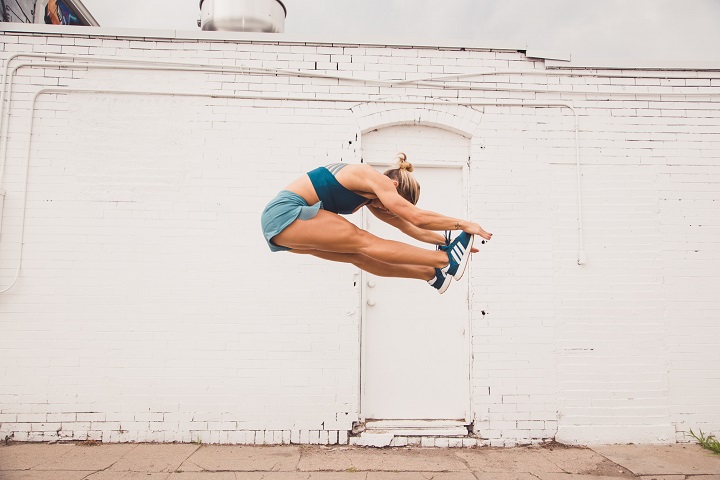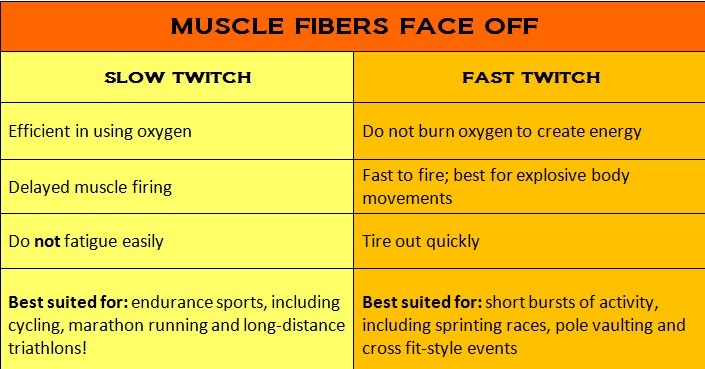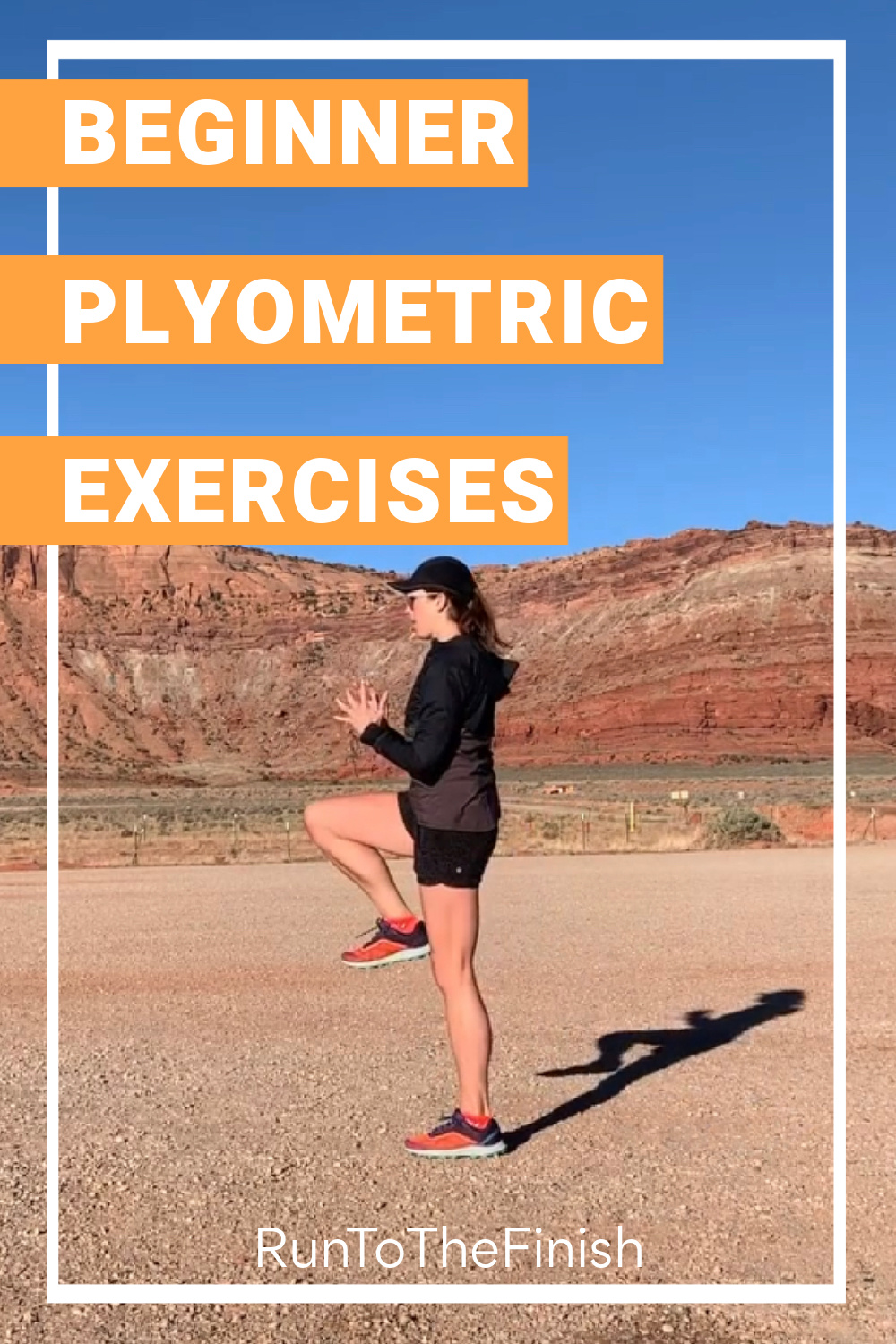If you’re like me, you probably wish you could do nothing but run for days on end. But I know that in order to become an even better runner, it’s a good idea to diversify my movements and workouts. Beginner plyometric exercises are ideal as we ease in to this different type of intensity for both new and seasoned runners (yes, especially masters runners!!).
Full of explosive movements and jumps, plyometric exercises help to increase speed, strength, balance, and agility.
How could a runner say no to that?
You can easily do these beginner plyometric exercises to compliment your daily routine or as an integral part of a training plan for your upcoming marathon. Believe me – once you get started, you’ll notice a difference quickly.
Please, remember that more and more intense is not better. Just like with your running, we are starting low to build over time for maximum benefits and no injuries.
What are Plyometric Exercises?
Also known as jump training, plyometric exercises include movements like burpees, box jumps, and jump squats. (and yes lower impact versions we shall discuss)
Every time you jump and land, your muscle fibers get stretched and then contracted. This movement is key to helping you exert your muscles in short periods of time. Think power in your push off or having a finishing kick.
People love plyometric exercises because they require no equipment and rely solely on body weight. It’s a great workout routine to focus on endurance and building strength (particularly in your abs, quads, and calves).
These exercises burn calories quickly and can be high-impact.
So you might think it’s only for people in peak physical condition or athletes focus on jumping, but beginners should include it in their routine as well.
When done carefully and implemented gradually, they’re great exercises for improving overall fitness.
And no… this is not a beginner move, but something that she worked up to over years!
Why Runners Should Care about Plyometric Exercises
Plyometric exercises and running go together like peanut butter and jelly. Many people use plyometrics as a form of training for high-impact sports, running included.
It boosts muscle power, strength, flexibility, and balance.
Enhances Stretch-Reflex Mechanism
One of the key benefits of plyometric training is its ability to enhance the stretch-reflex mechanism. This mechanism refers to the body’s automatic response to a rapid stretch of a muscle.
When a muscle is rapidly stretched, it contracts more forcefully in response, resulting in a more powerful movement.
By training the stretch-reflex mechanism through plyometrics, you can improve the efficiency of your muscle contractions and generate greater force.
Increasing Leg Strength
Most of the exercises primarily target the legs and glutes, making them great for runners looking to build their strength on their lower body. That being said you can easily find exercises to incorporate the upper body as well (like clap push ups and med ball tosses).
This type of training allows the body to become stronger and more efficient, which improves a runner’s speed.
Improving Running Economy
Studies have shown that in just six weeks, you can improve your running economy with plyometric exercises.
What does that mean? It means running the same speed with less effort, which allows you to improve your endurance. Or to run faster because it now feels easier.
This makes a lot of sense, since most of your runs are focused on slow twitch fibers. This high intensity work fires up the fast-twitch muscles, leading to more speed and builds some muscle!
Better Agility
Let’s be honest, runners tend to move in one direction.
And then suddenly, we’re forced to jump up on a curb or dodge a slick patch of ice during winter running. And bam, suddenly we’re injured because our bodies aren’t used to these quick changes.
Just a few minutes of plyo each week gives your muscles a chance to continue working in all directions and be ready for those unexpected movements.
Why We Need More Plyometrics with Age?
Don’t fool yourself in to thinking this is just a young runners game. Plyometrics are hugely essential for post-menopausal runners.
After menopause, most women have a low bone mineral density which can lead to osteoporosis.
According to this article, performing jumping exercises can help to increase osteogenic loading, which in turn helps to prevent osteoporosis. Just a few jumps a day can go a long way in keeping your bones healthy.
But beyond that, you’re going to really like this: they help with fat loss.
Due to the drop in estrogen our body stops using carbohydrates as efficiently and plyometric exercises help to offset that, as well as prevent muscle loss!
How to Incorporate Plyo with Running?
The biggest drawback to plyometrics is the potential for injury. Which is why I need you to commit to a few specific things:
- Always do a dynamic warm up and even a little jog before any plyo
- Start with these beginner moves, don’t try to impress anyone
- Start with low reps and build up over time
- Only do 1 session per week when starting out to see how your muscles respond to this change up
- Count this time towards your 20% of the week that’s above low heart rate or not easy
A great way to add them in is as a finisher to a strength workout, when you know your run the next day is an easy run and still a couple days out from your long run.
You could also do them at the end of an easy run. Again knowing that the next day is not speed work or a long run.
10 Beginner Plyometric Exercises to Try
Since this type of movement is considered high intensity and requires strong ligaments and joints, it’s best to ensure your body is ready for it. Make sure you’ve had at least a few months of consistent workouts under your belt before jumping in (literally).
Start off with some of the easier exercises listed below before you get going with the more challenging plyometric training. This is best for your body and your health!
1. Drop Jumps
This exercise is great for activating the glutes, hamstrings, and quadriceps. Over time, it helps to increase explosive strength and is a fabulous way to get ready for any big downhill race.
This includes jumping from a box 12-36 inches high. The height of the box is going to increase the difficulty.
- From standing atop the box, allow your right foot to lead you off the box
- Upon landing with knees bent, squat down only to gain momentum to jump up once again.
- Lift your arms in the air above, fully stretching out your body before you come to a natural landing.
- Repeat movement.
View this post on Instagram
I don’t recommend doing this on the stairs, unless on the bottom step. Otherwise you’ll be leaping forward, which is not the goal of this movement.
And if you can only do the down, not the additional jump, that’s a great starting point. You are teaching your body how to absorb more impact!
2. Skater Hop
Skater hops are great for building balance between either side of the body, targeting all the muscles in the leg. Soccer players love these!
- Stand feet with a little closer than hip-width apart.
- Bend your right knee while also slowly raising your left foot off the ground, thinking about leaping to the left using the power from your right leg.
- Quickly push off your right leg, landing on your left foot and allowing your right leg to swing behind you (yup just like the way an ice skater looks).
- Make sure to keep your landing soft and on a bent leg, your arms will help you flow through the movement.
- Repeat movement going the other direction.
Remember the intensity of this movement can be increased or decreased based on how far you jump to the side.
For a low impact starting version, try a small hop and when you land allow the foot that crosses behind to touch the ground.
Video demo of the skater and jumping lunges (number 6 below).
3. Squat Jumps
This exercise also works on your balance and overall strength. Runners will benefit from this for any quick movements while out pounding the pavement.
Here is how to do a full tuck jump:
- Stand with your feet shoulder-width apart and with your knees slightly bent.
- Squat down and bend your knees to gain momentum and jump up as high as you can while tucking your knees into your chest.
- Upon landing, swing your arms back and repeat the movement.
But I want you to start with a low impact version.
Instead of actually leaving the ground, you are going to squat and swing the arms, but only raise up on your toes.
4. Frog Jump
Target your glutes, hamstrings, and quadriceps with this amphibian-inspired movement. This one is a great beginner plyometric exercise.
- Stand in a wide squat position with your feet angled outwards.
- Jump up and forward, softly landing.
- Jump up and backward, making sure to maintain your squatting position.
- Repeat movement.
5. Touch Down Jack
Jumping jacks are beginner plyometric exercises that everyone loves…or at least I really love this one. It feels doable because my body already knows what to expect from a jumping jack.
The touch-down jack is taking it one step further, with a little inspiration from America’s favorite sport.
- Stand in a wide squat position with both feet angled outwards.
- While in the position, squat down to touch your hands to the ground.
- From there, jump up and out of the position and bring your arms and legs together (a jumping jack!)
- Jump again and bring yourself back into the original squatting position to repeat the movement.
6. Jumping Lunges
A more advanced plyometric exercise, this move will target all areas of the lower body – and you’ll definitely feel it too!
- Start in a normal lunge with your weight evenly distributed.
- Launch your body and switch your legs and arms while in the air.
- Lower your body gently into a lunge onto the opposite side of your body.
- Repeat movement.
So what to do if you aren’t here yet? Post knee surgery, this particular move hurt me for awhile, so I started by simply doing reverse lunges. Those are often easier on the knees that front lunges.
Then add in some step ups and just keep allowing your knees to build strength and don’t be afraid to simply try the move occasionally to see how it feels.
Video shows the half tuck jump, the low impact jumping lunge and an option for modified high knees.
View this post on Instagram
7. Burpee
One of the most well-known plyometric exercises out there, the burpee gets the heart rate pumping and the whole body moving.
- From a standing position, bring your body down into a squatting position.
- Place your hands on the ground as you jump your feet back into a plank.
- Do a push-up.
- Jump your feet forward and your body back into a squatting position.
- Explosively jump up and land gently back into your original squatting position.
- Repeat movement.
To take the intensity down, you will step one foot back at a time in the plank position and then step one foot forward at a time to stand up.
You can also eliminate the push up!
Remember we want to first get good form and the slowly test ourselves over time with progressions.
8. High Knees
Simple to the eye, high knees are an excellent movement to activate your core and lower body. Rather than reps, high knees are performed in duration.
- Stand shoulder-width apart with your arms at your sides.
- Bring your right knee to your chest, slightly above waist level. At the same time, move your left arm up in a pump.
- Quickly lower your arm and leg, as though running in place.
- Repeat the movement with your left knee and your right arm.
- Alternate between both knees for your allotted time.
Again if you need to modify this from the more intense approach. Instead of running in place, make it more like a march. Quickly bring up one knee and then pause forcing yourself to have good balance and then quickly switch to bring the other knee up.
9. Power Skips
YES, just like you’re a kid again.
Skipping is an incredible way to build your power off the ground.
- From a standing position push your right foot in to the ground
- While bring your left knee up and swinging your right arm back
- All of this should propel you forward
- Start with low knees and keep the amount you push off the ground low
- Over time you’ll increase your steadiness and power to get further off the ground or power farther forward
10. Jumping Rope
Another old school method that gets left in the dust, but works!
You can start out with an imaginary rope, but feel free to grab one when you’re feeling more comfortable.
- With both feet on the ground and slight bend in the knees
- Push off the ground with both feet at the same time
- Thinking about your feet and ankles acting as springs
- You’ll leave the ground and upon coming back down land with a slight bend still in the knees
- Repeat for 20 reps
Over time you’ll have more force and may jump higher, you’ll also increase the number of reps.
Advanced Plyometric Exercises
Once you’ve mastered the essential plyometric exercises, you can advance to more challenging movements that push your limits.
Advanced plyometric workouts are designed to take your explosive power, strength, and athleticism to the next level. These exercises require a high level of coordination, balance, and control.
Incorporating these advanced movements into your training routine will not only enhance your performance in sports and athletic activities but also help you build a more resilient and powerful body.
Depth Jumps
Depth jumps are an advanced plyometric exercise that builds explosive power. This exercise targets your lower body muscles, including your quadriceps, hamstrings, glutes, and calves.
To perform a depth jump, stand on a box or platform, step off, then immediately explode upward as soon as your feet touch the ground.
Focus on landing softly and absorbing the impact through your muscles rather than your joints. Repeat the movement for a desired number of repetitions.
When performing depth jumps, it’s important to maintain proper form and technique. Ensure that your knees are aligned with your toes during the landing phase, and avoid excessive bending or collapsing of your knees.
Start with a lower box height and gradually increase the height as you become more comfortable and proficient with the exercise.
Plyometric Push-ups
Plyometric push-ups are a dynamic variation of the traditional push-up exercise. This explosive movement targets your chest, shoulders, triceps, and core muscles.
Begin in a push-up position, then lower yourself into a deep push-up before explosively pushing yourself off the ground.
As you push off, clap your hands together in mid-air, demonstrating your explosive power and control. Land softly and immediately go into the next repetition.
When performing plyometric push-ups, it’s important to maintain a strong and stable core throughout the movement. Engage your abdominal muscles to prevent your lower back from sagging or arching excessively.
If you find it challenging to perform clap push-ups, you can start by practicing explosive push-ups without the clap, gradually progressing to the full movement.
Single-Leg Hops
Single-leg hops are an excellent plyometric exercise for improving balance, stability, and power. This exercise targets your lower body muscles, including your quadriceps, hamstrings, glutes, and calves, while also challenging your coordination and proprioception.
Stand on one leg, then explosively jump forward as far as you can, using your arms for momentum. Land softly on the same leg, maintaining your balance, and immediately repeat for a desired number of repetitions before switching legs.
When performing single-leg hops, it’s important to focus on maintaining proper alignment and control. Keep your knee in line with your toes during the landing phase, and avoid excessive inward or outward movement of your knee.
Start with shorter jumps and gradually increase the distance as your strength and stability improve.
Remember, advanced plyometric workouts require a solid foundation of strength and conditioning. It’s important to warm up adequately, perform proper progressions, and listen to your body to avoid overtraining or injury.
Safety Tips for Plyometric Training
While plyometric exercises offer a myriad of benefits, it’s important to prioritize safety to prevent injuries and achieve optimal results. By following these safety tips, you can minimize the risk of injury and make the most out of your plyometric workouts.
Proper Warm-Up and Cool-Down Techniques
Before diving into a plyometric workout, it’s important to warm up thoroughly. Engage in light cardiovascular exercise, such as jogging or cycling, for about 5-10 minutes to increase your heart rate and warm up your muscles. This will help improve blood flow and prepare your body for the high-intensity movements ahead.
In addition to cardiovascular warm-up, dynamic stretching is also important. Perform exercises that mimic the movements you’ll be doing during your plyometric workout, such as high knees, butt kicks, and leg swings. Dynamic stretching helps improve your range of motion and activates the muscles you’ll be using.
After your workout, it’s equally important to cool down properly. Cool-down exercises, such as walking or light jogging, help gradually decrease your heart rate and prevent blood from pooling in your muscles.
Follow this up with static stretching, holding each stretch for 15-30 seconds, to promote muscle recovery and flexibility.
Importance of Correct Form and Technique
Maintaining proper form and technique is vital for preventing injuries and maximizing the effectiveness of plyometrics. When performing plyometric exercises, focus on landing softly to minimize the impact on your joints. Land on the balls of your feet and roll through to your heels, engaging your glutes and hamstrings to absorb the shock.
Furthermore, ensure your core is engaged throughout each exercise. A strong core helps stabilize your body and maintain proper alignment, reducing the risk of injury. Keep your back straight, chest lifted, and avoid rounding your shoulders.
It’s also important to start with exercises that match your fitness level and gradually progress. Master the basic movements before moving on to more advanced variations. This will help you develop the necessary strength and coordination to perform plyometrics safely and effectively.
Avoiding Overtraining and Injury
Plyometric training is demanding on the muscles and joints, so it’s important to avoid overtraining to prevent injuries. Overtraining can lead to muscle imbalances, fatigue, and decreased performance. Allow for adequate rest and recovery between plyometric workouts, especially if you’re new to this type of training.
Listen to your body and pay attention to any signs of pain or discomfort. If you experience persistent pain, it’s essential to consult with a healthcare professional or a certified trainer to address any underlying issues.
Gradually progress the intensity and volume of your exercises over time. Start with 1-2 sessions per week and gradually increase the frequency as your body adapts. Remember, quality is more important than quantity when it comes to plyometric training.
Incorporating other types of training, such as strength training and flexibility exercises, can also help prevent overuse injuries and improve overall performance. A well-rounded fitness routine will not only enhance your plyometric training but also promote overall health and well-being.
By following these safety tips, you can enjoy the benefits of plyometric training while minimizing the risk of injury. Remember to always prioritize safety and listen to your body.
With proper form, technique, and gradual progression, plyometrics can be a valuable addition to your fitness routine.
Frequently Asked Questions about Beginner Plyometric Exercises
Let’s jump in to a few of the questions you might be having about adding this new style of training to your week.
Can Beginners do Plyometric Training?
Many beginners shy away from plyometric training as you need to start off slow and work your way up. It’s a very intense workout that needs to be done correctly to get the full benefits. When starting out, try doing your exercises with a trained professional first to ensure that you’re doing them correctly.
Can Anyone Do Plyometrics?
Plyometrics are very beneficial for a lot of different people. In fact, many professionals use this form of exercise in physical rehab after accidents. Once again, it’s about doing the movements correctly and easing into them.
Anyone with arthritis or bone or joint issues should not perform plyometric workouts. Pregnant women should also avoid these types of jumping movements. Check with your doctor if you have any kind of chronic health condition before starting.
Why is it Important to Warm Up Before Doing a Plyometric Workout?
Since these exercises are high intensity, you don’t want to start doing them without warming up first. A quick 5-10 minutes of light cardio beforehand, such as jogging, will work as a great warmup. You can also do some dynamic stretching, such as skipping or walking lunges. This helps to prevent injuries like with any workout.
For beginners, start off with fewer reps and sets, gradually increasing them as your strength builds. Begin with simpler, less intense plyometric exercises and work your way up.
When to Start Plyometric Training?
Before you being plyometric training, make sure you have mastered your basic bodyweight movements such as squats and push-ups. These are fundamental movements that will work their way into the plyometric exercises.
From there, you should have the basic movements covered to begin doing plyometric exercises properly. It’s best to do these after you’re done running. You can also have a day dedicated to strength training to avoid overworking the body.
Don’t forget your recovery days. They should stay as recovery days to help recoup the body where no plyometric exercises or running takes place!
Final Thoughts on Plyometric Exercises
While pro athletes swear by plyometric exercises, they’re a worthwhile effort for at-home fitness enthusiasts too. Runners can greatly benefit from adding some strength and agility training to their routine, leading up to faster movements and quicker runs.
Proper form is integral for your workout. Always consult a professional to make sure you’re doing the movement safely and effectively. They can give you great feedback and insight on how to improve your technique.
Looking for more ways to build your strength?
Let me know which of these plyometric exercises for beginners you find most helpful. Enjoy your workout!
Other ways to connect with Amanda
Instagram Daily Fun: RunToTheFinish
Facebook Community Chatter: RunToTheFinish
Sign Up to Receive a Weekly Newsletter with Top Running Tips and Laughs





 Piriformis Syndrome Exercises: Alleviating a Pain in the Butt
Piriformis Syndrome Exercises: Alleviating a Pain in the Butt
